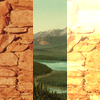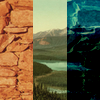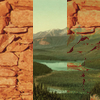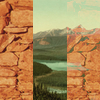blend()#
Blends a region of pixels from one image into another (or in itself again) with full alpha channel support.
Examples#

def setup():
py5.background(py5.load_image("rockies.jpg"))
img = py5.load_image("bricks.jpg")
py5.image(img, 0, 0)
py5.blend(img, 0, 0, 33, 100, 67, 0, 33, 100, py5.ADD)

def setup():
py5.background(py5.load_image("rockies.jpg"))
img = py5.load_image("bricks.jpg")
py5.image(img, 0, 0)
py5.blend(img, 0, 0, 33, 100, 67, 0, 33, 100, py5.SUBTRACT)

def setup():
py5.background(py5.load_image("rockies.jpg"))
img = py5.load_image("bricks.jpg")
py5.image(img, 0, 0)
py5.blend(img, 0, 0, 33, 100, 67, 0, 33, 100, py5.DARKEST)

def setup():
py5.background(py5.load_image("rockies.jpg"))
img = py5.load_image("bricks.jpg")
py5.image(img, 0, 0)
py5.blend(img, 0, 0, 33, 100, 67, 0, 33, 100, py5.LIGHTEST)
Description#
Blends a region of pixels from one image into another (or in itself again) with full alpha channel support. There is a choice of the following modes to blend the source pixels (A) with the ones of pixels in the destination image (B):
BLEND: linear interpolation of colors:
C = A*factor + BADD: additive blending with white clip:
C = min(A*factor + B, 255)SUBTRACT: subtractive blending with black clip:
C = max(B - A*factor, 0)DARKEST: only the darkest color succeeds:
C = min(A*factor, B)LIGHTEST: only the lightest color succeeds:
C = max(A*factor, B)DIFFERENCE: subtract colors from underlying image.
EXCLUSION: similar to DIFFERENCE, but less extreme.
MULTIPLY: Multiply the colors, result will always be darker.
SCREEN: Opposite multiply, uses inverse values of the colors.
OVERLAY: A mix of MULTIPLY and SCREEN. Multiplies dark values, and screens light values.
HARD_LIGHT: SCREEN when greater than 50% gray, MULTIPLY when lower.
SOFT_LIGHT: Mix of DARKEST and LIGHTEST. Works like OVERLAY, but not as harsh.
DODGE: Lightens light tones and increases contrast, ignores darks. Called “Color Dodge” in Illustrator and Photoshop.
BURN: Darker areas are applied, increasing contrast, ignores lights. Called “Color Burn” in Illustrator and Photoshop.
All modes use the alpha information (highest byte) of source image pixels as the blending factor. If the source and destination regions are different sizes, the image will be automatically resized to match the destination size. If the src parameter is not used, the display window is used as the source image.
This function ignores image_mode().
Underlying Processing method: blend
Signatures#
blend(
src: Py5Image, # an image variable referring to the source image
sx: int, # x-coordinate of the source's upper left corner
sy: int, # y-coordinate of the source's upper left corner
sw: int, # source image width
sh: int, # source image height
dx: int, # x-coordinate of the destinations's upper left corner
dy: int, # y-coordinate of the destinations's upper left corner
dw: int, # destination image width
dh: int, # destination image height
mode: int, # Either BLEND, ADD, SUBTRACT, LIGHTEST, DARKEST, DIFFERENCE, EXCLUSION, MULTIPLY, SCREEN, OVERLAY, HARD_LIGHT, SOFT_LIGHT, DODGE, BURN
/,
) -> None
blend(
sx: int, # x-coordinate of the source's upper left corner
sy: int, # y-coordinate of the source's upper left corner
sw: int, # source image width
sh: int, # source image height
dx: int, # x-coordinate of the destinations's upper left corner
dy: int, # y-coordinate of the destinations's upper left corner
dw: int, # destination image width
dh: int, # destination image height
mode: int, # Either BLEND, ADD, SUBTRACT, LIGHTEST, DARKEST, DIFFERENCE, EXCLUSION, MULTIPLY, SCREEN, OVERLAY, HARD_LIGHT, SOFT_LIGHT, DODGE, BURN
/,
) -> None
Updated on March 06, 2023 02:49:26am UTC
